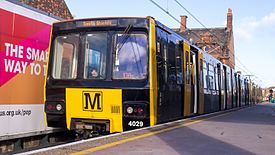Tyne & Wear Metro
| Tyne and Wear Metro | |
|---|---|
 |
|

Metro train at South Shields.
|
|
| Overview | |
| Type | Rapid transit/light rail |
| Status | In Use |
| Locale | Tyne and Wear |
| Stations | 60 |
| Services |
Green line (Airport-South Hylton) Yellow line (St James-South Shields) |
| Daily ridership | 109,600 (2015) |
| Ridership | Over 40 million (2015) |
| Operation | |
| Opened | 11 August 1980 |
| Owner | Public |
| Operator(s) |
Nexus Arriva UK Trains |
| Depot(s) | South Gosforth |
| Technical | |
| Line length | 74.5 km (46.3 mi) |
| Track gauge | 1,435 mm (4 ft 8 1⁄2 in) |
| Electrification | 1500 V DC |
| Operating speed | 80 km/h (50 mph) |
Durham Coast Line omitted for clarity
The Tyne and Wear Metro, referred to locally as simply The Metro, is a rapid transit and light rail system in North East England, serving Newcastle upon Tyne, Gateshead, South Tyneside, North Tyneside and Sunderland in the Tyne and Wear region. It has been described as the first modern light rail system in the United Kingdom.
The initial network opened between 1980 and 1984, using converted former railways lines, linked with new tunnel infrastructure. Extensions to the original network were opened in 1991 and 2002. In 2015/16 40 million passenger journeys were made on its network of 74.5 kilometres (46.3 mi). It is the second-largest of the four metro systems in the United Kingdom, after the London Underground; the others being the Docklands Light Railway and the Glasgow Subway. It is operated by DB Regio Tyne & Wear Limited, a subsidiary of Arriva UK Trains under contract to Nexus.
The present system uses much former railway infrastructure, mostly constructed between 1839 and 1882. One of the oldest parts being the Newcastle & North Shields Railway (between Newcastle and North Shields) opened in 1839. In 1904, in response to tramway competition which was taking away passengers, the North Eastern Railway (NER) started electrifying parts of their local railway network north of the River Tyne with a 600V DC third-rail system, forming one of the earliest suburban electric networks, known as the Tyneside Electrics. In 1938, the line south of the Tyne between Newcastle and South Shields was also electrified. Falling passenger numbers, and the need to renew life expired infrastructure and rolling stock, meant that the Tyneside Electric network was de-electrified in the 1960s under British Rail, and converted to diesel operation. The Newcastle-South Shields line was de-electrified in 1963, and the north Tyneside routes were de-electrified in 1967.
...
Wikipedia
